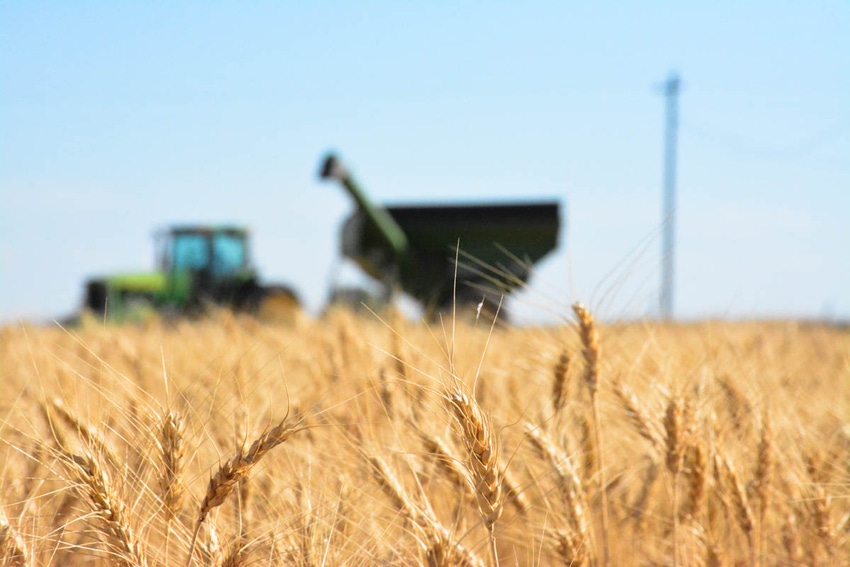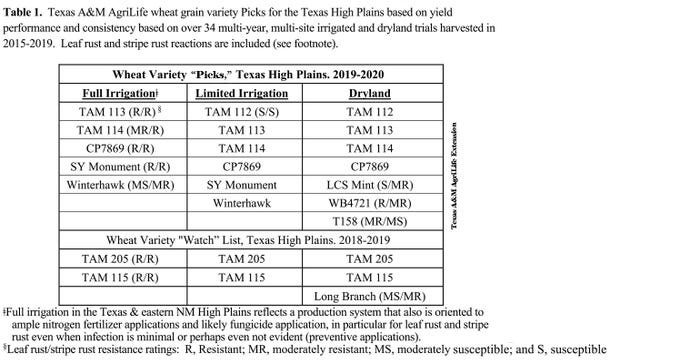August 5, 2019

A mixed bag of weather conditions may have reduced the number of planted wheat acres in the Texas Panhandle during the 2018-2019 season. But for Texas A&M AgriLife wheat-trial researchers, the erratic conditions proved to be an opportunity to learn more about the varieties used to develop their annual top wheat "Picks" list.
“Because it was an extreme production season for wheat farmers, it was a very good year to evaluate wheat varieties across our variety trials,” said Dr. Jourdan Bell, AgriLife Extension agronomist, Amarillo. Growers experienced everything from record wheat yields to waterlogged fields resulting in reduced yields and shriveled, low test weight grain, to fields that were either hailed out or severely damaged by hail.
“Across the Texas High Plains, much of the early wheat for grazing or dual-purpose production was drilled into good soil moisture,” Bell said. “This resulted in good stands and good early forage production.”
However, when the rain stopped at the end of the October, late wheat was dry sowed, and the winter drought resulted in producers pulling cattle off dryland wheat pasture early due to a lack of forage, she said. But while late-spring rain resulted in the "excellent" recovery of the wheat, rain paired with hail in the eastern and northeastern Panhandle resulted in significant waterlogging and hail injury to wheat fields.
Planted wheat acres for grain were also down due to increased cotton acres and wheatlage, Bell said. However, in some areas, the wheatlage was not chopped as fields were too wet, and much of the intended wheatlage went to grain.
In the western and southwestern Panhandle, cool conditions and ideal precipitation resulted in dryland yields approaching 80 bushels per acre on some fields; however, the regional average was approximately 40 bushels per acre. Irrigated wheat ranged from 70 to 100 bushels per acre depending on irrigation capacity and precipitation timing and amount. Hailstorms also affected the region's wheat yields, she added.
DETERMINING PICKS
Annually, prior to planting, Bell and Dr. Calvin Trostle, AgriLife Extension agronomist, Lubbock, join with Dr. Jackie Rudd, AgriLife Research wheat breeder, Amarillo, to provide HIgh Plains wheat producers a "Picks” list of varieties with the highest potential. Criteria for the list include a minimum of three years of irrigated or dryland data in Texas A&M AgriLife regional variety trials across numerous locations.
“A 'Pick' variety can be described as varieties we would choose to include on our farm for wheat grain production," said Trostle, "given the three-year performance and variety characteristics."
"Picks" are not necessarily the top yielders but are selected based on their end-use quality, disease resistance traits, insect tolerance, and/or standability, he added.
The summaries are derived from wheat variety trials coordinated by the Texas A&M AgriLife wheat improvement program in Amarillo, with funding provided by variety trial entry fees as well as the Texas Wheat Producers Board.
TOP PICKS

TAM 112
Drought tolerance and resistance to the wheat curl mite, which provides tolerance to wheat streak mosaic virus, keeps TAM 112 on the limited irrigated and dryland lists, Rudd said. However, TAM 112, unlike most of the other Picks, is susceptible to leaf and stripe rust, and is also susceptible to lodging under high irrigation and high nitrogen, so is not recommended for full irrigation.
TAM 113
“Varieties placed on our Watch List show promise but have insufficient data. Sometimes we only have two years available to make a conclusion,” Trostle said.
TAM 113 remains on the list because of solid grain performance, forage potential and its ability to emerge under stressful conditions, he said. It has moderate resistance to stripe and leaf rusts. Likewise, TAM 114 remains strong with good yields and a solid rust-resistance package, and is a common replacement for TAM 111, which was removed from the Picks list two years ago due to increasingly inconsistent performance.
WINTERHAWK
Winterhawk, WB4721 and LCS Mint have continued to perform well for more than four years in Texas High Plains production, Rudd said. Dyna-Gro Long Branch will remain on the watch list. It has a good grain yield potential, but milling properties are not as good as other varieties and test weights are below average. T158 remains on the dryland list because of continued good performance under dryland conditions.
TAM 204
“We often receive inquiries about TAM 204, also,” he said. “Although it is not on the Picks list because of marginal bread-making quality, TAM 204 is the most popular ‘beardless’ variety. It is especially valuable because it can be used for grazing alone, grazing and grain, and unlike varieties with awns, it can be grazed-out.”
CHANGES
The following changes were made to the 2019/2020 Wheat Grain Variety "Picks" list:
Croplan CP7869 is a new addition, evaluated since 2016-2017 production year. Released in 2018, it is well adapted for both irrigated and dryland conditions. In all years, it has been a top-yielding variety with good test weights, straw strength and a leaf disease package.
Syngenta Monument is another addition as a top yielder in the High Plains Uniform Variety Trials, or HPUVT, irrigated trials for more than four years with good test weights. It is resistant to stripe and leaf rust. It was not placed on the dryland Picks List because it was not evaluated in 2018-2019 dryland trials.
Oklahoma State University’s Iba was dropped because it has not maintained an upper yield potential compared to newer varieties. Both TAM 304 and Limagrain T158 were dropped from the irrigated lists. TAM 304 does not have the upper yield potential of newer varieties in the High Plains environment, and T158 was no longer evaluated in 2018-2019 High Plains irrigated trials.
TAM 115 and TAM 205 are new varieties on the watch list with a solid three-year and two-year history, respectively, in the HPUVT trials. TAM 115 is a dual-purpose variety resistant to leaf rust, stripe rust, stem rust, greenbug and wheat curl mite with excellent drought tolerance. TAM 205 is a dual-purpose variety with a high top-end yield potential, good test weights, good fall forage production and resistance to leaf rust, stripe rust, stem rust and wheat streak mosaic virus.
PlainsGold Avery, a Colorado variety, was removed from the watch list as ongoing results were insufficient to promote the variety for dryland.
Click here, to view the complete, "Wheat Production Summary and Grain Variety Picks for the Texas High Plains."
Source: is AgriLife TODAY, which is solely responsible for the information provided and is wholly owned by the source. Informa Business Media and all its subsidiaries are not responsible for any of the content contained in this information asset.
You May Also Like




